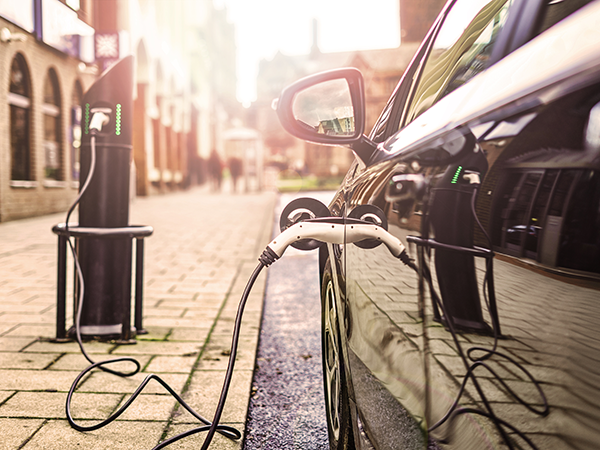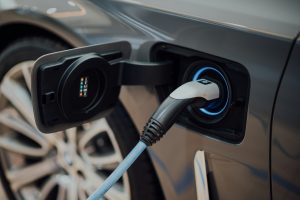Electric vehicle adoption relies on investment into infrastructure

Driven by changing consumer behaviours, increasing choice and affordability, recent net-zero pledges by governments and the desire to ‘Build Back Better’ after the pandemic, the demand for electric vehicles (EVs) continues to grow. According to Bloomberg New Energy Finance, 1 EV sales will rise to nearly 60% of the global auto market by 2040, a huge shift from almost 0% in 2010. With consumer consciousness on the rise and market forces gaining momentum, EVs are quickly becoming the future of the automotive industry and a target market for investors.
However, before any serious adoption of EVs can take place there needs to be significant investment in the infrastructure that supports EVs. This includes the charging points but also the entire electricity grid.
EV charging points
The issue of sufficient access to electric charging points for those who don’t have the access to off-street parking needs to be addressed if there is to be widespread adoption of EVs. A report by the European Automobiles Manufacturers association 2 in October 2020 showed that while EV sales in Europe had increased over 100% during the last 3 years, the number of public charging points had grown by just 58%. Similarly, in the UK, all-electric cars went from 1.6% of the market in 2019 to 6.6% in 2020. 3 The report found the UK is likely to need around 400,000 public charge points by 2030, a considerable increase from the existing 35,000. The current installation rate of 7000 a year is not enough to meet requirements if the UK is to be ready for the ban on sales of cars with an internal combustion engine in 2035. Installation will need to occur five times faster at a cost of between £5 billion and £10 billion by 2030. 4
Providing enough residential on-street charge points and charging facilities in public spaces will be critical in high-density residential areas where it’s simply not feasible for every property to have cables running from their electricity supply to their vehicle. National Grid points out that with 20 million EVs on the road there will be at least 8.6 million vehicles that will not have the facilities for charging at home. 5
This is not just an issue for the UK though. The quantity of public chargers is growing the fastest in China, followed by Europe and then the US. China still has the largest network of public chargers. They had more than 500,000 chargers by 2019, accounting for more than 50% of the global total. However, a large number of chargers does not mean an ideal vehicle-to-charger ratio. While China’s passenger electric vehicle-to-public charger ratio (8.5 to 1) is lower than that of the United States (17 to 1), some European countries have even lower EV to public charger ratios (France: 7 to 1; Germany: 5 to 1; and the Netherlands: 4 to 1). 6
Electricity demand
The second major infrastructure to consider is the supply and distribution of the electricity itself. At their current trajectory EVs are set to double domestic electricity demand. At scale, this would present significant challenges to the distribution network. As we see increased adoption of intermittent
Renewable energy
What does this mean for investors?
The UK government recognises that widespread adoption of EVs is key to achieving their climate goals with the Chancellor announcing in the government’s spring Budget that £500 million will be invested into a rollout for charging hubs.
7
Whilst this investment will help play a role in piecing together the UK’s fragmented infrastructure and easing the pressure on public sector organisations, more capital for wider and faster deployment of a national charging grid is needed. Many supermarkets are now providing electric charging hubs in their car parks in partnership with others.
8
Many supermarkets in the UK have increased their commitments to
Sustainability
Despite the noise and potential in companies like
Tesla, Nio and others, for example,Volkswagen,
9
the EV story also represents plenty of opportunities for investors outside the main car manufacturing segments. Charging points are the next logical step but looking at the sector more broadly there are opportunities in smart metering,
Battery storage
For example, smart meters (electronic devices that accurately monitor electricity use and send this information to the user or the utility company to effectively manage and optimise energy consumption) are key to driving efficiency in energy usage. They can potentially manage the demand on the grid by notifying consumers of the best time to charge, helping reduce consumer costs. Renewable electricity providers are also starting to provide ‘free’ tariffs for EV owners to manage potential cost implications.
The market for smart meters is growing rapidly and in 2019 US electric companies installed over 98 million smart electric meters, covering more than 70% of US households. The global smart meter market size was valued at $21.13 billion in 2019 and is projected to reach $39.20 billion by 2027, an annualised growth rate of 9%. 10 Utility companies are keen to install meters, they enhance the energy grid’s resilience and operations and help provide visibility into the system operations, thereby avoiding outages.
Similarly, the
Battery storage
With all investment opportunities, however, comes risk. The widespread adoption of electric vehicles comes with some stings in the tail, most notably the use of rare earth and precious metals used in the battery and technology embedded in the vehicles themselves. Complex supply chains, sometimes in politically unstable geographies and/or where the rule of human rights may be less robust, increase the risk of human rights abuses, as well as environmental degradation. As investors it is essential to be aware of and manage these risks. Doing so can uncover solution opportunities, for example, in businesses dedicated to the recycling of these rare earth minerals at end of life in many rechargeable battery applications.
Global governments have built widespread adoption of EVs into their carbon neutral plans which will have major implications not just for the way we travel but the way we build cities and our consumption of electricity itself. For investors, it’s important to look at the bigger picture and recognise that the opportunity set is much wider than a few automobile names.




